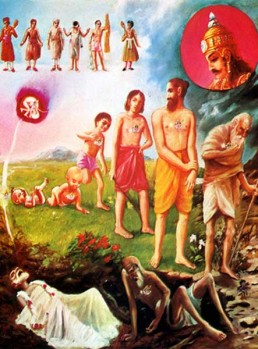Swami Chinmayananda Commentary
To renounce all desires is to destroy completely the last vestures of one’s ego. Renunciation of ego is not a state of dull, meaningless emptiness. Where the delusory ego has ended, the State of Full-Knowledge, or Selfhood, has dawned. To realise the Self in one’s own bosom is to realise at once the Self which is All-pervading and Eternal (Brahman).
When the ego has ended, the Consciousness is not known to be anything other than the Eternal, and as such the Knower of Truth, in a brilliant experience of the Self, becomes the Self, and therefore, this state is called Self-hood (Brahmi-sthitih).
A doubt may still arise that even after this realisation, we may again fall into the delusion of the ego and come to suffer the ego’s world of imperfections and sorrows. To deny this tragedy, we have been told how, having realised the Self once, no more can the individual fall back into his ancient delusions. This experience of the Self need not necessarily take place in the very youthful days of one’s life. Even in old age — nay, even in the last moment of this embodiment — if a seeker can come to experience, even for a moment, this egoless State of Tranquillity and Poise, even a passing glimpse of the Selfhood, it is sufficient to gain this Brahmic-State pointed out in Vedantic literature.
“Negation of the false and assertion of the True” is the Path that has been indicated in the Upanishads. The very same path, in its practical application, is designated here in the Geeta, in Vyasa’s original contribution, as Karma Yoga. To work without attachment and desires, egoism and vanity, ever in perfect equilibrium in both success and failure, is to deny the ego its entire field of activity, and unconsciously to assert the greater Truth, the Self. Thus, in technique, the Geeta’s Karma Yoga is not at all different from the Vedantic Technique of Meditation. But Arjuna got confused and perplexed because he took Krishna’s words too literally, and therefore, in the following chapter, he expresses his mental confusion in the opening lines. The Lord, therefore, explains Karma Yoga exhaustively in the next chapter.
Adi Sankara Commentary
O Partha, esa, this, the aforesaid; is brahmisthitih, the state of being established in Brahman, i.e. continuing (in life) in indentification with Brahman, after renouncing all actions. Na vimuhyati, one does not become deluded; prapya, after attaining ; enam, this Rcchati, one attains; brahma-nirvanam, identification with Brahman, Liberation; sthitva, by being established; asyam, in this, in the state of Brahman-hood as described; api, even; anta-kale, in the closing years of one’s life. What need it be said that, one who remains established only in Brahman during the whole life, after having espoused monasticism even from the stage of celibacy, attains indetification with Brahman!
The Bhagavad Gita with the commentary of Sri Sankaracharya – Translated by Alladi Mahadeva Sastry
Holy Geeta – Commentary by Swami Chinmayananda
The Bhagavad Gita by Eknath Easwaran – Best selling translation of the Bhagavad Gita
The Bhagavad Gita – Translation and Commentary by Swami Sivananda
Bhagavad Gita – Translation and Commentary by Bhaktivedanta Swami Prabupadha
Srimad Bhagavad Gita Chapter 2 – Verse 72 – 2.72 esha brahmi – All Bhagavad Gita (Geeta) Verses in Sanskrit, English, Transliteration, Word Meaning, Translation, Audio, Shankara Bhashya, Adi Sankaracharya Commentary and Links to Videos by Swami Chinmayananda and others – 2-72

